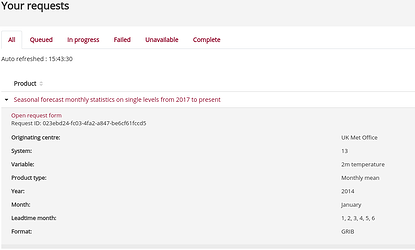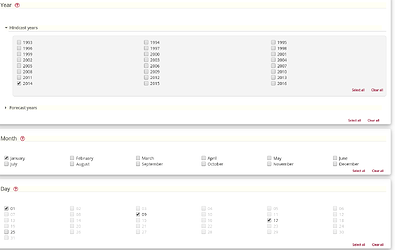For Met Office hindcast, monthly statistics or anomalies of month M include individual members numbered from 0 to 27 (so 28 in total). These members are actually initialized on the 1st of the month M and 25th, 17th, 9th of previous month M-1 (with 7 realizations for each of these start dates).
The corresponding initialization dates for the individual members of monthly products are as follows:
member 0: 1st of month M realization 1
member 1: 1st of month M realization 2
............
member 6: 1st of month M realization 7
member 7: 25th of month M-1 realization 1
member 8: 25th of month M-1 realization 2
............
member 13: 25th of month M-1 realization 7
member 14: 17th of month M-1 realization 1
member 15: 17th of month M-1 realization 2
............
member 20: 17th of month M-1 realization 7
member 21: 9th of month M-1 realization 1
member 22: 9th of month M-1 realization 2
............
member 27: 9th of month M-1 realization 7
Usually, the Met Office forecast include monthly products with individual members from 0 to maximum 61 (so 62 in total). This depends on the number of days in the previous month: for example products for August will have 62 members in total, while products for March will have only 56 members in total (non-leap years). There are 2 realizations per day and the start dates are 1st of the current month M and all days of previous month M-1 except the 1st:
member 0: 1st of month M realization 1
member 1: 1st of month M realization 2
member 2: last day of month M-1 realization 1
member 3: last day of month M-1 realization 2
............
last member: 2nd of month M-1 realization 2
So the numbering of monthly products members starts with the most recent initialization date and goes back in time.
However, there are (rare) exceptions when for Met Office forecast we don't have the "usual" 2 realizations per day. This is explained in footnote (c) on page https://confluence.ecmwf.int/display/COPSRV/Seasonal+forecasts+and+the+Copernicus+Climate+Change+Service#SeasonalforecastsandtheCopernicusClimateChangeService-production_schedules
(c) Due to the flexibility of the Met Office forecasting system, forecast failures on a given date are not usually recovered by re-running the missed forecasts at a later date, but by running more members with initial conditions of the day of recovery.
Example: An incident affected the 22 August 2017 forecast so no members are available for that date. Instead, 4 members were initialised on 23 August 2017.
Also, please note that only the first most recent 50 members of Met Office forecasts are used to generate the graphical products for Met Office or C3S multi-model combination displayed on C3S web, as explained in footnote (b) on the same page:
(b) The production schedule of the Met Office forecasting system doesn't prescribe how to build an ensemble for a specific nominal start date. The following choices are currently in use for the C3S products based on GloSea5 data:
FORECASTS: the most recent 50 members starting on or before the 1st of the month. (NOTE: The data from all the daily members, and not just those 50 used to produce the C3S forecast products, is processed and made available through the CDS)
HINDCASTS: 28 members (7 starting on the 1st of the month and 7 on each of the 9th,17th and 25th of the previous month)
In the future, we will include new metadata in the monthly products that will provide details on the initialization of a specific ensemble member.

